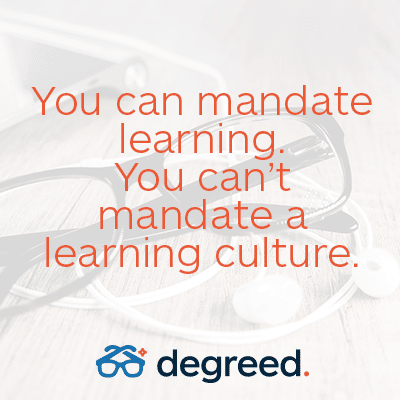Did you miss our webinar on Building a Learning Culture? Catch up with this wrap-up and tell us your thoughts on learning cultures by tweeting us @Degreed
First, why build a learning culture?
In 2009, Bersin by Deloitte surveyed 40,000 organizations to see how they used various HR & training processes and how they performed on 10 business measures. They discovered “Among all the HR and training processes we study, the single biggest driver of business impact is the strength of an organization’s learning culture.” The study found the following about High-Impact Learning Cultures:
-32% more likely to be first to market
-58% more likely to have skills to meet future demand
-37% greater employee productivity
Here’s how to start building a Learning Culture that can bring lasting payoffs.
Of a survey we administered, 89% of learners would rather be given credit for their own learning than learn at HR’s direction. It is an impossibility for you to know the needs, desires, goals, and real-time challenges for every individual within your organization, so how can you be expected to tailor fit learning initiatives that are top down? You can’t. It has to come from the bottom up.
For a Learning Culture to thrive, you must give the freedom to learn to the individual. It doesn’t matter what they learn, just that they are learning. Employees have goals and desires outside of our organizations, but part of their lives is their work. This means that while people will desire to learn about things like WWII history, and deep sea diving, they will also want to learn how to become better at their jobs within our organizations. Focus on making learning social, and implement it using these 3 key principals:
1. Trust. Trust that your employees want to develop new skills, and they will spend some time learning things that will improve their jobs within your organization.
2. Empower. Empower your employees to learn with time, money, and resources. For example, at Degreed, every employee is given $100 in FlexEd money a month to support whatever learning they want.
3. Personalize. Support people’s own unique learning strategies.
When the strategy, objectives, and policies are established and communicated within the organization, the culture and action can follow.
Here are the 3 big takeaways for building learning cultures:
1. Learning cultures focus on the needs of the employee and empower them to achieve their dreams.
2. For learning cultures to develop, it doesn’t matter what people learn.
3. Alignment is achieved through strong mission, strategy, & clear objectives.
Do you have questions about building a learning culture? Tweet them to us @degreed and check out the full webinar here:



